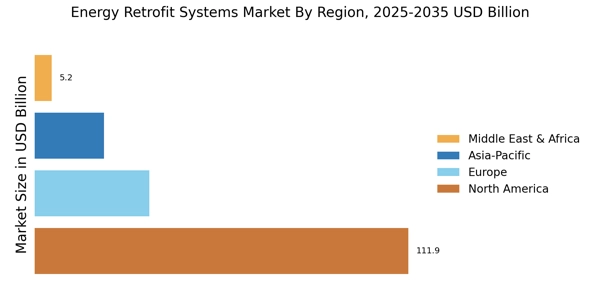Rising Energy Costs
The increasing cost of energy is a primary driver for the Energy Retrofit Systems Market. As energy prices continue to rise, consumers and businesses are compelled to seek solutions that enhance energy efficiency. This trend is evident in various sectors, including residential, commercial, and industrial. For instance, energy costs have surged by approximately 20% over the past five years, prompting a shift towards energy-efficient systems. The Energy Retrofit Systems Market is positioned to benefit from this shift, as retrofitting existing buildings with energy-efficient technologies can significantly reduce energy consumption and costs. Furthermore, the potential for long-term savings on energy bills makes retrofitting an attractive option for many stakeholders, thereby driving market growth.
Technological Innovations
Technological innovations are reshaping the Energy Retrofit Systems Market by introducing advanced solutions that enhance energy efficiency. Innovations such as smart building technologies, energy management systems, and high-performance insulation materials are becoming increasingly prevalent. These technologies not only improve the effectiveness of retrofitting but also provide real-time data that helps in optimizing energy use. For instance, the integration of IoT devices allows for better monitoring and control of energy consumption in buildings. As these technologies continue to evolve, they are expected to drive the demand for energy retrofit systems, as stakeholders seek to leverage cutting-edge solutions to achieve energy savings and operational efficiency.
Government Incentives and Rebates
Government incentives and rebates play a crucial role in stimulating the Energy Retrofit Systems Market. Various governments have implemented programs aimed at encouraging energy efficiency improvements through financial incentives. These initiatives often include tax credits, grants, and rebates for businesses and homeowners who invest in energy-efficient retrofitting. For example, in certain regions, homeowners can receive rebates of up to 30% on the cost of energy-efficient upgrades. Such financial support not only lowers the initial investment barrier but also enhances the return on investment for energy retrofit projects. Consequently, the presence of these incentives is likely to accelerate the adoption of energy retrofit systems, thereby propelling the market forward.
Increased Awareness of Climate Change
The growing awareness of climate change and its impacts is significantly influencing the Energy Retrofit Systems Market. As individuals and organizations become more conscious of their carbon footprints, there is a heightened demand for solutions that mitigate environmental impact. Energy retrofitting is recognized as a viable strategy to reduce greenhouse gas emissions, as it enhances the energy efficiency of existing buildings. Reports indicate that buildings account for nearly 40% of global energy-related carbon emissions. This realization drives stakeholders to invest in energy retrofit systems, as they seek to align with sustainability goals and regulatory requirements. The Energy Retrofit Systems Market is thus likely to experience growth as more entities prioritize eco-friendly practices.
Urbanization and Infrastructure Development
Urbanization and infrastructure development are significant factors driving the Energy Retrofit Systems Market. As urban areas expand, there is a pressing need to upgrade existing infrastructure to meet modern energy efficiency standards. Many cities are facing challenges related to aging buildings and increased energy demand. Retrofitting these structures with energy-efficient systems is seen as a practical solution to address these challenges. According to recent estimates, urban areas are projected to account for over 70% of the global population by 2050, leading to increased energy consumption. This trend underscores the necessity for energy retrofitting, as it not only enhances building performance but also contributes to sustainable urban development. The Energy Retrofit Systems Market is thus likely to thrive in response to these urbanization trends.


















Leave a Comment